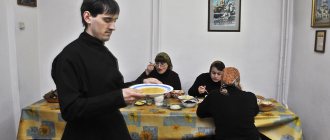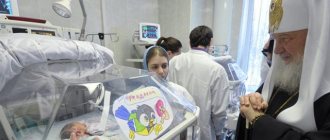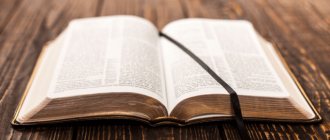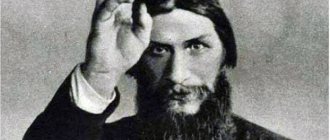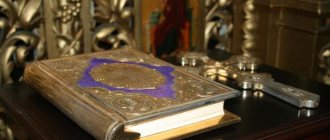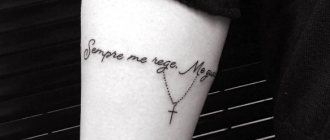Bright Week
The content of the article
This is the name for the 7 days of celebrating Holy Easter - from Easter proper to St. Thomas Week. During Bright Week, fasting on Wednesday and Friday and bowing to the ground are canceled.
Every day after the liturgy, a festive procession of the cross takes place, and all bells are rung every day throughout the week.
On Friday, when the celebration of the icon of the Mother of God “Life-Giving Spring” takes place, after the liturgy there is, according to custom, a small consecration of water.
The eight days of celebrating Christ's Resurrection are, as it were, one day belonging to eternity, where “there will be no more time” (Rev. 10:6).
Starting from the day of Easter until it is celebrated (on the fortieth day), believers greet each other with the Easter greeting “Christ is Risen!”, “Truly He is Risen!”.
Some features of the service on Holy Week
Since the times of the apostles, the solemn celebration of Christian Easter, like the Old Testament, continues for a whole week. The entire week, called Bright Week, is like one great holiday of Easter. The Fathers of the Church and the 66th canon of the VI Ecumenical Council command believers to practice psalms and spiritual songs in churches throughout Bright Week, triumphant and rejoicing in the Risen Lord.
Rejoicing and triumphing in Christ, and listening to the reading of the Divine Scriptures and enjoying the Holy Mysteries. For in this way, together with Christ, we will be resurrected and ascended. For this reason, on the said days there should not be horse riding or any other folk spectacle.” Remembering the great benefits shown to the human race by the resurrection of Jesus Christ, ancient Christians on the great holiday of Easter extended their hands of help and charity to the lesser brethren of Christ, such as: debtors, orphans, the poor and the wretched. Evidence of ancient Christian charity on the days of Holy Easter still remains the distribution of consecrated brushes, ordinary food products and cash benefits to the poor, in order to make them, on this bright holiday, participants in joy, which is always the fruit of mercies and good deeds.
Divine services on Bright Week are performed with the royal doors open - as a sign that the Lord, with His Resurrection, opened the doors of heaven to believers. They remain open after the service, starting from the first day of Easter, throughout the week and close only on Saturday before 9 o’clock.
Throughout Easter week, the beginning and end of church services are celebrated in the same way as on the first day (but the procession of the cross takes place on subsequent days not before Matins, but after the liturgy).
At Matins, the Theotokos (the creation of Theophan and Joseph), printed in the Colored Triodion, are added to each song of the Easter canon. The priest performs each litany with the Cross and the tricandlestick (or candle), and the small litanies are pronounced only after the 3rd, 6th and 9th cantos.
The liturgy is performed in exactly the same way as on the first day. The Prokeimenon, the Apostle, the Alleluia and the Gospel for each day of Bright Week are special, and the Gospel is read by only one deacon (that is, in one language).
Participated in all days - one and the same: Receive the Body of Christ, taste the immortal source
An ancient holy custom, preserved even today by pious laity, is not to omit a single church service during the entire Holy Week.
Easter: how to spend Bright Week?
“Whoever is pious and God-loving, now enjoy this wonderful and joyful celebration!” - says Saint John Chrysostom in his jubilant Catechesis for Easter. And then he continues: “Everyone enjoy the feast of faith, everyone perceive the wealth of goodness!” The 66th canon of the Sixth Ecumenical Council speaks about how to celebrate Easter and spend Bright Week: “From the holy day of the Resurrection of Christ our God until the next Sunday, throughout the week the faithful must continually practice psalms, singing, and songs in the holy churches spiritual, rejoicing and triumphant in Christ, and listening to the reading of the Divine Scriptures, and enjoying the Holy Mysteries.” So, does the Church call us to take communion on Svetnaya every day? But usually before communion we fast, confess and specially prepare by reading a rather lengthy prayer rule, and Bright Week is a time of breaking the fast, festive fun and relaxation after a long fast of abstinence. How to be?
Unfortunately, Easter is often presented to a person not as a Feast of holidays and a Triumph of celebrations, but just as an excuse to finally eat non-Lenten food
Archpriest Arkady SHATOV, rector of the Church of the Holy Blessed Tsarevich Demetrius in the First City Hospital, chairman of the Commission on Church Social Activities, explains:
— The services of Bright Week are structured so that a person can go to church on all days and partake of the Holy Mysteries of Christ. The prayer rule these days is special - Easter and very short. The hours and evening service are also short - everything is adapted so that anyone can go to church every day. Easter is unconditional joy, joy in spite of everything. All seven days of Bright Week are like one continuous day. It feels like the sun doesn’t set these days—the same service is repeated, and it’s almost entirely sung, not read. It is not necessary to fast on these days, because we have already fasted throughout Lent before this. Such frequent communion on Bright Week is a reward for those who keep the fast. Why did we fast for 48 days (40 days of Lent, and then Holy Week)? Precisely in order to receive communion on Easter. Before Communion on these days, prayers for Communion (without psalms), the canon for Communion and the canon of Easter are read instead of all other canons.
As for confession on Easter, different priests have different practices.
Some people only read the prayer of permission, others allow them to receive communion on the first day after Easter without confession.
Of course, it is difficult to take communion every day. It is rather an ideal to strive for. And it’s hard for us to rejoice. It is more difficult to rejoice than to repent and cry about sins.
In our church, we usually allow people to receive communion on any three days of Bright Week. If people fasted, prepared for Easter, but spent this week outside the Church, did not participate in the Sacrament of the Eucharist, it turns out that they climbed, climbed the mountain - and fell back down again. We broke our fast, ate meat, and that was it. And if a person has prepared and now, to the best of his ability, tries to go to church and receive communion on Bright Week, then he remains at this peak and then descends from it more slowly. If you don’t live like this, then sometimes a person becomes despondent after Easter.
Bright Week is not a time of spree, you cannot indulge in all sorts of bad things, spend time in the cinema, theater, read books voraciously, eat excessively, spouses abstain from marital communication at this time. Easter is the joy of the Kingdom of Heaven. In the Kingdom of Heaven we will not eat meat, go to the cinema, we will not read detective books, we will not play computer games - but there will be more joy there than here on earth! The saints left the world for this joy. The Monk Sergius of Radonezh went into the forest not because he decided to punish himself, not to marry, not to have children. He left and there he found perfect joy, that joy that exceeds all earthly joys combined. Motovilov felt this joy when the Monk Seraphim of Sarov showed him what it means to be in the Holy Spirit. We must try to join in this joy during Bright Week.
This joy is felt in the temple. After all, many unbelievers and non-church people come to the Easter service. Why? They are attracted by this joy, this mystery of the Resurrection.
During the days of Bright Week, it is good to remember the disadvantaged and, if possible, try to share your joy with them
These days, of course, you can do good, you can walk in nature, go to visit people - but you need to remember Christ. True joy will be with Christ.
The meaning of Christianity is Easter.
It is very difficult for us to constantly be at this height, so we inevitably go down, and St. Seraphim, for example, always lived with this joy. “My joy, Christ is risen!” - he said on all days of the year. And the Apostle Paul says: “Rejoice always” (1 Thess. 5:16). Christianity is Easter joy. The all-surpassing joy of victory over death, over evil, the joy of deliverance from hell, deliverance from the power of the devil. This is the joy of the resurrection of Christ.
Bright Week. Easter Holy Days
Bishop Alexander (Mileant)
The Russian people still celebrate Easter. Despite many years of preaching of unbelief, thousands of people gather in Orthodox churches on the night of the Resurrection of Christ, tens of thousands consecrate Easter food. Russian hearts respond to the colossal charge of joy, renewal, and enlightenment that the greatest of Orthodox holidays carries. But for most, immediately after the first day of Easter, weekdays begin and the celebration stops. In fact, the Holiday lasts much longer, because Easter joy is so great that it cannot be limited to one day!
The Lord remained on earth after the Resurrection for exactly 40 days. All this time of worship of the Orthodox Church takes us back to the night of Holy Easter. "Christ is Risen!" - we greet each other and kiss each other three times. The most solemn, joyful and majestic week is the first week (Church Slavic “week”) after Easter, which is called Easter.
On Bright Week, “everything and everything” is Christ, the risen Christ. The fast is over, the time of weeping and sorrow, the whole world rejoices and praises the Lord. Every morning, at the end of the liturgy, a procession of the cross is held, symbolizing the procession of the myrrh-bearing women to the tomb of Christ. During the religious procession, worshipers walk with lit candles.
All services of Bright Week are performed with the Royal Doors open, so that any of us can observe the sacred rites in detail. The open Royal Doors are an image of the Holy Sepulcher, from which an Angel rolled away the stone. This week there is no fasting on Wednesday and Friday, but one must avoid binge eating, which is so easy to fall into after a long fast.
On Friday of Bright Week, the icon of the Mother of God “Life-Giving Spring” is commemorated, and after the liturgy the water is consecrated. The next day, on Bright Saturday, artos is distributed to the pilgrims. There are no weddings or funeral prayers on Bright Week. Funeral services for the dead are performed, but more than half of them consist of Easter hymns.
The Resurrection of Christ is the cornerstone of the Orthodox faith.
The Apostle Paul teaches: “If Christ has not been raised, then our preaching is in vain, and so is our faith” (1 Cor. 1:514). The joy of Easter night is a breakthrough into the Kingdom of Heaven, the beginning of the endless joy of paradise. How happy were the saints, such as St. Seraphim of Sarov, who was honored to constantly have in his soul the memory of the Resurrection and greeted everyone who came to him with the words:
"My joy! Christ is Risen"
Divine services on Bright Week are performed with the royal doors open - as a sign that the Lord, with His Resurrection, opened the doors of heaven to believers. They remain open after the service, starting from the first day of Easter, throughout the week and close only on Saturday before 9 o’clock.
Throughout Easter week, the beginning and end of church services are celebrated in the same way as on the first day (but the procession of the cross takes place on subsequent days not before Matins, but after the liturgy).
At Matins, the Theotokos (the creation of Theophan and Joseph), printed in the Colored Triodion, are added to each song of the Easter canon. The priest performs each litany with the Cross and the tricandlestick (or candle), and the small litanies are pronounced only after the 3rd, 6th and 9th cantos.
The liturgy is performed in exactly the same way as on the first day. The Prokeimenon, the Apostle, the Alleluia and the Gospel for each day of Bright Week are special, and the Gospel is read by only one deacon (that is, in one language).
Communicated all days - one and the same: Receive the Body of Christ, taste the immortal source.
On Friday, according to tradition, a service to the Most Holy Theotokos is added to the Easter service in honor of the renovation of the temple, called the “Life-Giving Spring.”
The liturgy is performed in exactly the same way as on the first day. The Prokeimenon, the Apostle, the Alleluia and the Gospel for each day of Bright Week are special, and the Gospel is read by only one deacon (that is, in one language).
Communicated all days - one and the same: Receive the Body of Christ, taste the immortal source.
After the Liturgy on this day, the blessing of water is usually performed.
On Saturday, according to the prayer behind the pulpit, at the liturgy, a prayer is read for the fragmentation of the artos, and there is a fragmentation and distribution of the artos.
Easter clock
Christ rose from the dead, trampling down death by death and giving life to those in the tombs. (Thrice)
Having seen the Resurrection of Christ, let us worship the holy Lord Jesus, the only Sinless One. We worship Your Cross, O Christ, and we sing and glorify Your holy Resurrection. For You are our God, don’t we know anything else; We call Your name. Come, all faithful, let us worship the Holy Resurrection of Christ: behold, joy has come through the Cross to the whole world. Always blessing the Lord, we sing His Resurrection: having endured the crucifixion, destroy death by death. (Thrice)
Having anticipated the morning of Mary, and having found the stone rolled away from the tomb, I hear from the angel: in the light of the ever-present Being, with the dead, why do you seek like a man? You see the graveclothes, preach to the world that the Lord has risen, the slayer of death, as the Son of God, saving the human race.
Even though you descended into the grave, Immortal, you destroyed the power of hell, and you rose again as a conqueror, Christ God, saying to the myrrh-bearing women: Rejoice, and grant peace to your apostles, grant resurrection to the fallen.
In the tomb carnally, in hell with the soul like God, in heaven with the thief, and on the throne you were, Christ, with the Father and the Spirit, fulfilling everything, indescribable.
Glory: Like the Life-Bearer, like the reddest of Paradise, truly the brightest palace of every king has appeared, Christ, Your tomb, the source of our Resurrection.
And now: Highly illuminated Divine village, rejoice: for You have given joy, O Theotokos, to those who call: Blessed are You among women, All-Immaculate Lady.
Lord have mercy. (40 times)
Glory to the Father and the Son and the Holy Spirit, now and ever, and unto ages of ages, amen.
We magnify You, the most honorable cherub and the most glorious seraphim without comparison, who gave birth to the Word of God without corruption, the real Mother of God.
Christ rose from the dead, trampling down death by death and giving life to those in the tombs. (Thrice)
Service stages
Festive services are held in a solemn atmosphere. The beginning of the Easter service and its end are regulated by the Liturgical Charter - Typikon.
On a note! Typikon is a book in which the days and hours of divine services are written, as well as the order of offering prayers contained in the Service Book and Book of Hours.
Start of service
The Easter service begins late in the evening on Holy Saturday. As a rule, the start time of the Easter service is shortly before midnight. It takes about 5 hours. Approximate start and end times: from 23-00 or 23-30 to 3 am. In general, the service on Easter at night lasts about 4 hours.
